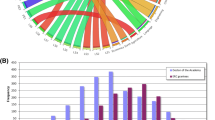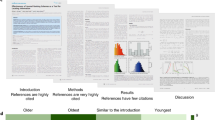Abstract
Not all highly cited papers have the same citation life cycle curves, i.e. curves of frequency of citations received vs. time. The citation life of ten randomly selected Citation Classics, five in medicine and five in biochemistry, are studied longitudinally in time and compared with a random sample of ten non-classics of the same cohort. There are pronounced differences in the life cycle curves; two distinct types are suggested. Type A, comprised of both high and low cited papers in both fields, has an early peak of citation rate and may be approximated by a bilinear cumulative citation curve with a break at six years of age, when three quarters of the total number of citations have occurred. Type B, in this study comprised of extremely highly cited methodological Citation Classics, exhibit a constant or slowly accelerating growth rate with a vigorous citation life extending over the entire period studied and typically one third or less of the total citations accumulated at six years of age.
Similar content being viewed by others
References
M. Line, A. Sandison, Obsolescence and changes in the use of the literature with time,Journal of Documentation, 30 (1974) 284–351.
D. de Solla Price,Little Science, New York, Columbia University Press, 1963.
R.E. Burton, R.W. Kebler, The half-life of some scientific and technical literatures,American Documentation, 11 (1960) 18–22.
R.L. Dahling, Shannon's information theory: The spread of an idea, In:Studies of Innovation and of Communication to the Public, Stanford, California, Institute for Communication Research, 1962, pp.119–130.
S.T. Cole, The growth of scientific knowledge, theories of deviance as a case study, In:The Idea of Social Structure: Papers in the Honour of R.K. Merton,L.A. Coser, (Ed.), New York, Harcourt, Brace, Jovanovitch, 1975, pp. 175–220.
R.K. Blashfield, Feigner et al.: Invisible colleges and the Matthew effect,Schizophrenia Bulletin, 8 (1982) 1–2.
F. McMurtray, J.M. Ginski, Citation patterns of the cardiovascular serial literature,Journal of the American Society for Information Science, May–June, (1972) 172–175.
V.M. Motylev, Study into the stochastic processes of change in the literature citation pattern and possible approaches to literature obsolescence estimation,International Forum for Information and Documentation, 6 (1981) 3–12.
N.L. Geller, J.S. de Cani, R.E. Davies, Lifetime-citation rates; A mathematical model to compare scientist's work,Journal of the American Society for Information Science, Sept.–Oct. (1981) 333–336.
S. Arunachalam, U.N. Singh, Publication and citation patterns in the literature of a high metabolism area: The case of superconductivity in 1970,Journal of Information Science, 8 (1984) 93–102.
M.B. Line, Citation decay of scientific papers: Variation according to citations received,Journal of Information Science, 9 (1984) 90.
M.B. Line, Does physics literature obsolescence? A study of variation of citation frequency with time for individual journal articles in physics,BLL Review, 1 (1974) 84–91.
E.S. Aversa,Citation Patterns of 400 Scientific Papers and Their Relationship to Literature Again, PhD Dissertation, Philadelphia, Drexel University, 1984, 178p.
K. McCain, K. Turner, Citation analysis and aging patterns of journal articles in Molecular Genetics,Scientometrics, 17 (1989) 127–163.
A. Avramescu, Actuality and obsolescence of scientific literature,Journal of the American Society for Information Science, Sept. (1979) 296–303.
A. Avramescu, Theoretical foundation of Bradford's law,International Forum for Information and Documentation, 5 (1980) 15–22.
E. Garfield, 100 Classics from The Lancet,Current Contents, 39 (1984) 3–13.
E. Garfield, The 100 most cited papers ever and how we select citation classics,Current Contents, 23 (1984) 3–9.
E. Garfield, Citation classics-Four years of the human side of science,Current Contents, 22 (1981) 5–15.
A. Mendez, I. Gomez, Comparison of citation classics in three fields of science,Scientometrics, 15 (1989) 621–632.
B.B. Peritz, Are methodological papers more cited tham theoretical or empirical one? The case of sociology,Scientometrics, 5 (1983) 211–218.
S. Cozzens, What do citations count? The rhetoric-first model,Scientometrics, 15 (1989) 437–449.
Author information
Authors and Affiliations
Rights and permissions
About this article
Cite this article
Cano, V., Lind, N.C. Citation life cycles of ten citation classics. Scientometrics 22, 297–312 (1991). https://doi.org/10.1007/BF02020003
Received:
Issue Date:
DOI: https://doi.org/10.1007/BF02020003




